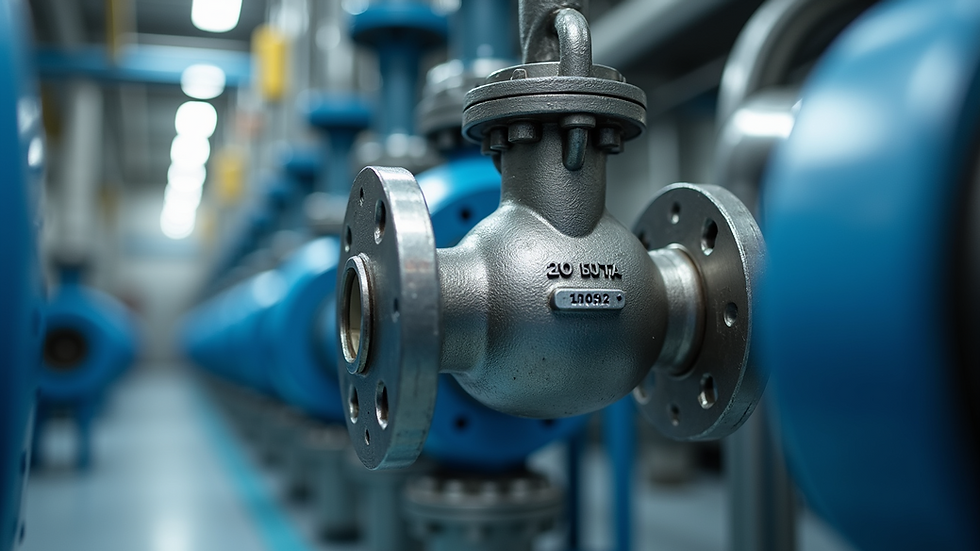Understanding the Functions and Uses of Butterfly Valves
- Mark Richardson
- Jul 9
- 4 min read
Butterfly valves are essential components in many industrial applications. These valves are used to control the flow of liquids and gases through pipes. While they may appear simple in design, butterfly valves offer numerous advantages, including space efficiency, low cost, and ease of operation. This article will delve into the functions and uses of butterfly valves, helping you understand when and why to use them.
Overview of Butterfly Valves
Butterfly valves consist of a disc that rotates on a shaft. When the disc is parallel to the flow, the valve is in the "open" position, allowing substances to pass freely. Conversely, when the disc turns perpendicular to the flow, the valve is in the "closed" position, blocking the passage. This straightforward operation is what makes butterfly valves popular across various industries, including water treatment, oil and gas, and HVAC systems.

Applications of Butterfly Valves
Butterfly valves are versatile and adaptable, finding applications in multiple sectors. For instance, they are widely used in water treatment facilities to manage the flow of water through pipelines. The 4 inch butterfly valve is commonly employed in these systems due to its compact size and effective operation.
Another notable application is in HVAC systems, where butterfly valves control the flow of air. They are often used as dampers in ductwork to regulate airflow, achieving optimal temperature control and energy efficiency. In the food and beverage industry, butterfly valves are employed to handle slurries and various types of fluids safely.

Benefits of Using Butterfly Valves
When it comes to valve selection, butterfly valves stand out for several reasons:
Space Efficiency: Butterfly valves require less space compared to other valve types, such as gate or globe valves. This makes them ideal for cramped installations and networks with limited available room.
Cost-Effective: They are generally less expensive to manufacture than many other types of valves, which can lead to significant savings, especially for large projects requiring many valves.
Quick Operation: The operation of butterfly valves is quick and easy. A quarter turn is typically all that is needed to fully open or close the valve. This feature is particularly useful in emergency situations where immediate action is required.
Reduced Pressure Drop: Due to their design, butterfly valves create less turbulence and friction in flowing liquids. This results in a reduced pressure drop across the valve, which can enhance overall system efficiency.
These benefits make butterfly valves a favorite choice among engineers and operators alike.

Types of Butterfly Valves
Butterfly valves come in several types, each designed for specific applications:
Concentric Butterfly Valves: These are the most common type and have the disc positioned concentric to the pipe. They are suitable for on-off and throttling services.
Eccentric Butterfly Valves: In these valves, the disc is offset from the centerline, which allows for better sealing and larger flow areas, making them ideal for applications handling viscous fluids.
Double Offset Butterfly Valves: This design features two offsets, allowing the valve to create a tighter seal and is particularly effective in high-pressure applications.
Triple Offset Butterfly Valves: These valves have three offsets and are suitable for high-performance applications where zero leakage is necessary.
Choosing the right type of butterfly valve depends on the specific requirements of your application, including pressure, temperature, and fluid type.
Key Considerations When Selecting Butterfly Valves
When selecting butterfly valves for a project, there are several key considerations to keep in mind:
Material: Butterfly valves can be made from various materials, including stainless steel, carbon steel, and PVC. The material should be selected based on the fluid being controlled and operating conditions.
Size: Properly sizing a butterfly valve is crucial. An oversized or undersized valve can lead to inefficiencies, increased wear, or even system failure. For instance, a common practice in many industrial applications is to use a 4 inch butterfly valve, balancing the size and the flow rate effectively.
Type of Actuation: Butterfly valves can be operated manually or with the help of actuators. Pneumatic, electric, and hydraulic actuators are commonly used and can facilitate automation in larger systems.
Pressure Rating: Ensure that the selected butterfly valve fits the pressure specifications of your application. There are pressure ratings for various types, so choose accordingly.
By taking these factors into account, you can ensure that you select the right butterfly valve for your particular application.
Final Thoughts on Butterfly Valves
Understanding the functions and uses of butterfly valves is essential for anyone involved in process control and management. Their versatility, cost-effectiveness, and quick operation make them a valuable choice. Whether you're working in water treatment, HVAC, or any other industry, knowing how to select the appropriate butterfly valve can enhance system efficiency and reliability.
With the comprehensive knowledge gathered in this article, you are now better equipped to make informed decisions regarding butterfly valves for your projects. Whether considering a standard concentric design or exploring options like the 4 inch butterfly valve, the insights provided here will guide you effectively.



Comments